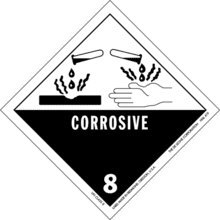
In the pantheon of hazardous waste materials, Class 8 corrosive liquids and corrosive waste stand out from other hazardous materials because of one significant characteristic property—Class 8 corrosive materials are those that cause full thickness destruction of human skin at the point of contact within a specific time period. If they leak during transportation they will cause material damage or even destroy other goods they contact during transport. In other words, Class 8 materials are extremely dangerous, with a potential for destruction, and must be handled with caution and sensitivity.
What Defines Corrosive Waste?
As defined by the EPA, corrosive liquids are those materials specifically listed as hazardous or have a level of corrosivity as a characteristic property. Corrosive materials have the property or quality to corrode, erode or eat away other materials on contact. Corrosive substances have the capability to severely attack and destroy metals, inorganic and organic polymers, and other organic compounds, including living tissues. Many of these types of wastes are generated from common industrial, manufacturing, petrochemical or commercial processes and must be shipped and disposed of properly.
Common Types of Class 8 Corrosive Waste
Class 8 hazardous liquids are one of 9 classes of material that has the ability to cause harm to humans, animals, or the environment. Though Class 8 corrosive substances may generate solid wastes, they are more commonly liquids, in the form of acid solutions and alkaline or base solutions. The corrosivity of an acid or base solution is measured by a numerical value on the pH scale. The pH levels of liquids are measured on a scale from 0 to 14, with pure water having a pH reference point of 7. A pH less than 7 is acidic while a pH greater than 7 is alkaline or basic. Strong acids have a pH at or under 2, while the pH of strong alkali bases are at or above 12.
For example, acids like hydrochloric acid have a pH level of 1.1 and are used for salt and water purification, and for fireworks, leather, batteries and various building materials. Sulfuric acid has a pH equal to 0.5 and is exceptionally dangerous. It is used in the production of explosives, fertilizers, lead-acid batteries, dyes, paints, and pigments. Nitric acid has a pH of 1.2. Though it can dissolve most metals, it is also used for removing warts.
Base cleaning products such as ammonia and bleach measure between 11-13 on the pH scale. The former is used as a material in soaps, textiles, detergents, inks, pharmaceuticals, and explosives, but is also used to clean glass or as an additive to food to control acidity. The latter, sodium hypochlorite, is used in food production, it also has applications in waste management, and for making bleach, disinfectants, and pesticides. Another base, potassium hydroxide, with a pH level as high as 12.7, is used in the production of fertilizers, biodiesel, and soft soaps.
In any event, whether the corrosivity of a solution is an acid or a base, its properties will burn just about any material or compound on contact and is the main reason that their handling and shipping require exceptional care with special attention to detail. Class 8 materials are divided into three numerical packing groups—I, II, and III—that is stratified by the relative severity that the corrosivity hazard poses. Packing Group I corrosive materials are the most severe and can cause full thickness destruction of skin tissue within an hour of being exposed to the solution for 3-minutes or less. Packing Group II causes the same full thickness destruction of intact skin tissue within 14 days after exposure to a corrosive substance from 3 to 60 minutes. Lastly, Packing Group III is for materials that do not meet the criteria of either Group I or II, and are subdivided into two numerical subgroups. Number 1 causes full thickness destruction of intact skin tissue within 14 days after 1 to 4 hours exposure, whereas number 2 doesn’t cause full thickness destruction of human skin tissue but corrodes steel or aluminum faster than a quarter inch a year at a test temperature of 130°F (55°C).
Regulations for Storing and Transporting Class 8 Corrosive Liquids
Class 8 liquids need to be stored in specific corrosion-resistant containers. For example, high-density polyethylene (HDPE) tanks are ideal for sulfuric acid. In general, acids and bases can be stored and transported in material made of glass, polymethyl pentene, or even Teflon. Most importantly, the container must be chemically resistant to the properties of the material within.
Once a packing group has been designated, shipping requirements would include generating a shipping manifest. Shipments must be in compliance with the law. The EPA offers a national hazardous waste electronic e-manifest system that tracks hazardous waste shipments from “cradle to the grave”. The Class 8 manifest is not unlike any other manifest in listing the contents of a cargo.
Class 8 labels are not only important but mandatory. They are the familiar diamond shape and graphically depict liquids spilling from two glass vessels that, respectively, are burning through a metal object and someone’s hand.
Contact the Hazardous Waste Experts at MLI Environmental
Companies and institutions transporting Class 8 hazardous materials must be certified in the shipment of dangerous goods and should consider professional hazardous waste management services like those offered by MLI Environmental.
MLI can identify and classify all hazards, including Class 8 corrosive liquids, and generate all dangerous goods documentation, markings, and labels required for companies to be in compliance. We also offer onsite services to prepare, package, and transport Class 8 materials from any location.
To inquire about our hazardous waste management services, please contact us at MLI Environmental today.
